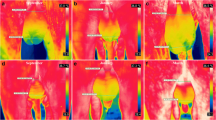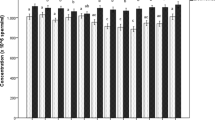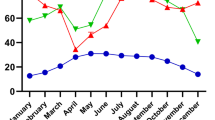Abstract
The objective of this study was to evaluate the influence of thermal stress indices and minimum temperature on the semen quality of dairy Gyr bulls and to determine whether the minimum night temperature is able to balance the thermal stress that occurred during the day. A total of 922 semen samples were collected from 391 bulls aged between 15 and 49 months, which participated in progeny pretest trials, from December 2011 to April 2017. Semen characteristics (ejaculate volume, gross motility, sperm motility, sperm vigor, sperm concentration, and percentage of total defects) and scrotal circumference were analyzed. Meteorological data were recorded daily by the National Institute of Meteorology. The analyses were carried out using mixed models. The following fixed effects were included in the model: test, month of sample collection, scrotal circumference, the age of the bull at sampling as covariate (linear regression), and the climatic variables (equivalent temperature index [ETI], temperature and humidity index [THI], or minimum temperature). The effect of the bull nested within the test was included in the model as a random effect. Two periods were considered to evaluate the effect of the climatic variables on sperm quality: 7 days before collection (period 1) and the day of collection (period 2). There was an effect of ETI on sperm vigor and concentration in both periods and on volume and percentage of total defects only in the second period. The THI exerted a significant effect on volume in both periods and on sperm motility and concentration only in the second period. There was an effect of the minimum temperature on ejaculate volume, sperm motility, sperm concentration, and percentage of total defects only in the second period, which corresponds to the day of semen collection. Taken together, the results show that there was sufficient thermal stress to negatively affect semen quality. However, the minimum temperature during the night was a significant factor that balanced these negative effects of THI and ETI on semen traits of Gyr bulls.
Similar content being viewed by others
References
Almeida Neto LA, Pandorfi H, Almeida GL, Guiselini C (2014) Climatização na pré-ordenha de vacas Girolando no inverno do semiárido. Ver. Bras. Eng. Agríc. Ambient. 18(10):1072–1078. https://doi.org/10.1590/1807-1929/agriambi.v18n10p1072-1078
Baêta FC, Meador NF, Shanklin MD, Johnson HD (1987) Equivalent temperature index at temperatures above the thermoneutral for lactating dairy cows. In: Meeting of the Am. Soc. Agric. Eng, Baltimore, 1987. Proceedings...Baltimore: Am. Soc. Agric. Eng, 21
Barros DV, Silva LKX, Lourenço Junior JB, Silva AOA, Silva AGM, Franco IM, Oliveira CMC, Tholon P, Martorano LG, Garcia AR (2015) Evaluation of thermal comfort, physiological, hematological, and seminal features of buffalo bulls in an artificial insemination station in a tropical environment. Trop Anim Health Pro 47:805–813. https://doi.org/10.1007/s11250-015-0792-9
Barth AD, Arteaga AA, Brito LFC, Palmer CW (2004) Use of internal artificial vaginas for breeding soundness evaluation in range bulls: an alternative for electroejaculation allowing observation of sex drive and mating ability. Anim Reprod Sci 84:315–325
Bloom E (1973) Ultrastructure of some characteristic sperm defects and a proposal for a new classification of the bull spermiogram. Nord Vet Med 25:383–391
Bohmanova J, Misztal I, Cole JB (2007) Temperature-humidity indices as indicators of milk production losses due to heat stress. J Dairy Sci 90:1947–1956. https://doi.org/10.3168/jds.2006-513
Brito LF, Silva AE, Barbosa RT, Unanian MM, Kastelic JP (2003) Effects of scrotal insulation on sperm production, semen quality, and testicular echotexture in Bos indicus and Bos indicus x Bos taurus bulls. Anim Reprod Sci 79:1–15. https://doi.org/10.1016/S0378-4320(03)00082-4
CBRA - Colégio Brasileiro de Reprodução Animal (2013) Manual para exame andrológico e avaliação de sêmen animal, 3rd edn. Belo Horizonte, p 104 ISBN 978-85-85584-05-4
Costa ANL, Feitosa JV, Montezuma PA, de Souza PT, de Araújo AA (2015) Rectal temperatures, respiratory rates, production, and reproduction performances of crossbred Girolando cows under heat stress in northeastern Brazil. Int J Biometeorol 59:1647–1653. https://doi.org/10.1007/s00484-015-0971-4
Cunha MS, Bonato DV, Taira AR, Teixeira PPM (2015) Degeneração testicular em machos: dos animais ao homem. Investigação 14:54–61 2177–4080
Fonseca VDFC, Cândido EP, Gonzaga Neto S, Saraiva EP, Furtado DA, Gama JP, Nascimento GV, Saraiva CAS, Almeida GHO (2016) Thermoregulatory responses of Sindhi and Guzerat heifers under shade in a tropical environment. Semina 37:4327–4338. https://doi.org/10.5433/1679-0359.2016v37n6p4327
Garcia AR (2006) Influência de fatores ambientais sobre as características reprodutivas de búfalos do rio (Bubalus bubalis). Rev Ciênc Agrár Belém 45:1–13
Garcia AR (2017) Degeneração testicular: um problema superado ou ainda um dilema? Rev bras reprod anim 41:33–39
Hahn GL (1999) Dynamic responses of cattle to thermal heat loads. J Anim Sci 77(Suppl. 2):10–20
Hansen PJ (2009) Effects of heat stress on mammalian reproduction. Philos Trans R Soc B 364:3341–3350. https://doi.org/10.1098/rstb.2009.0131
Hansen PJ (2013) Cellular and molecular basis of therapies to ameliorate effects of heat stress on embryonic development in cattle. Anim Reprod Sci 10(3):322–333
Holroyd RG, Doogan VJ, De Faveri J, Fordyce G, McGowan MR, Bertram JD, Vankan DM, Fitzpatrick LA, Jayawardhana GA, Miller RG (2002) Bull selection and use in northern Australia: 4. Calf output and predictors of fertility of bulls in multiple-sire herds. Anim Reprod Sci 71:67–79. https://doi.org/10.1016/S0378-4320(02)00026-X
Horn MM, Morae JCF, Galina CS (1999) Qualidade do sêmen de touros das raças Aberdeen Angus e Brangus-Ibagé frente à degeneração testicular experimental induzida por dexametasona. Cienc Rural 29:532–526. https://doi.org/10.1590/S0103-84781999000300024
Igono MO, Bjotvedt G, Sanford-Crane HT (1992) Environmental profile and critical temperature effects on milk production of Holstein cows in desert climate. Int J Biometeorol 36:77–87
INMET - Instituto Nacional de Meteorologia (2020) Ministério da Agricultura Pecuária e Abastecimento. Dados Históricos: http://www.inmet.gov.br/portal/index.php?r=bdmep/bdmep. Accessed 6 Feb 2020
Koivisto MB, Costa MTA, Perri SHV, Vicente WRR (2009) The effect of season on semen characteristics and freezability in Bos indicus and Bos taurus bulls in the southeastern region of Brazil. Reprod Domest Anim 44:587–592
Kumi-Diaka J, Nagaratnam V, Rwuaan JS (1981) Seasonal and age-related changes in semen quality and testicular morphology of bulls in a tropical environment. Vet Rec 108:13–15. https://doi.org/10.1136/vr.108.1.13
LCI (1970) Patterns of transit losses. Livestock Conservation, Inc, Omaha
Ledic IL, Tetzner TAD (2008) Alguns dados do Gir Leiteiro. In: In: Ledic IL and Tetzner TAD. Grandezas do Gir Leiteiro: o milagre zootécnico do século XX. Uberaba, 98-102
Lucio AC, Alves BG, Alves KA, Martins MC, Braga LS, Miglio L, Alves BG, Silva TH, Jacomini JO, Beletti ME (2016) Selected sperm traits are simultaneously altered after scrotal heat stress and play specific roles in in vitro fertilization and embryonic development. Theriogenology 86:924–933. https://doi.org/10.1016/j.theriogenology.2016.03.015
Martinez ML, Verneque RS, Teodoro RL (2000) Correlações entre características da qualidade do sêmen e a circunferência escrotal de reprodutores da raça Gir. Rev Bras Zootec 29:700–706
McManus C, Louvandini H, Carneiro HC, Lima PRM, Neto JC (2011) Production indices for dual purpose cattle in Central Brazil. Rev Bras Zootec 40(7):1576–1586. https://doi.org/10.1590/S1516-35982011000700025
Menegassi SRO, Barcellos JOJ (2015) Aspectos Reprodutivos do Touro: Teoria e Prática. Agrolivros, Guaíba, pp 1–280
Menegassi SRO, Barcellos JOJ, Dias EA, Koetz C, Pereira GR, Peripolli V, McManus C, Canozzi MEA, Lopes FG (2015a) Scrotal infrared digital thermography as a predictor of seasonal effects on sperm traits in Braford bulls. Int J Biometeorol 59:357–364. https://doi.org/10.1007/s00484-014-0847-z
Menegassi SRO, Pereira G, Dias EA, Koetz C, Lopes FG, Bremm C, Barcellos JOJ (2015b) The uses of infrared thermography to evaluate the effects of climatic variables in bull’s reproduction. Int J Biometeorol 60(1):151–157. https://doi.org/10.1007/s00484-015-1013-y
Menegassi SR, Pereira GR, Bremm C, Koetz C Jr, Lopes FG, Fiorentini EC, McManus C, Dias EA, Rocha MK, Lopes RB, Barcellos JO (2016) Effects of ambient air temperature, humidity, and wind speed on seminal traits in Braford and Nellore bulls at the Brazilian Pantanal. Int J Biometeorol:1–8. https://doi.org/10.1007/s00484-016-1167-2
Nascimento GV, Cardoso EDA, Batista NL, de Souza BB, Cambuí GB (2013) Indicadores produtivos, fisiológicos e comportamentais de vacas de leite. Agropec Cient Semi 9:28–36. http://150.165.111.246/ojs-patos/index.php/ACSA
Pereira JCC (2005) Fundamentos de Bioclimatologia Aplicados à Produção Animal. 1st edn. Belo Horizonte: FEPMVZ, 1-195
Pezzini TG, Sartor R, Silva TADSN, Pimentel CMM, Mariante ADS (2006) Características seminais de touros Curraleiros e Holandeses submetidos à insolação escrotal. Pesqui Agropecu Bras 41:863–868. https://doi.org/10.1590/S0100-204X2006000500020
Romanello N, Junior JDBL, Junior WB, Brandão FZ, Marcondes CR, Pezzopane JRM, Pantoja MHA, Botta D, Giro A, Moura ABB, do Nascimento Barreto A, Garcia AR (2018) Thermoregulatory responses and reproductive traits in composite beef bulls raised in a tropical climate. Int J Biometeorol 62(9):1575–1586
Santana Junior ML, Lopes PS, Verneque RS, Pereira RJ, Lagrotta MR, Peixoto MGCD (2010) Genetic parameters for reproductive traits of dairy Gyr breed males and females. Rev Bras Zootec 39:1717–1722. https://doi.org/10.1590/S1516-35982010000800013
Segnalini M, Bernabucci U, Vitali A, Nardone A, Lacetera N (2013) Temperature humidity index scenarios in the Mediterranean basin. Int J Biometeorol 57:451–458. https://doi.org/10.1007/s00484-012-0571-5
Silva RG, Morais DAE, Guilhermino MM (2007) Escolha de índices de estresse térmico para vacas Leiteiros em ambiente tropical. Rev Bras Zootec 36:1192–1198. https://doi.org/10.1590/S1516-35982007000500028
Thom EC (1959) The discomfort index. Weatherwise 12:57–61. https://doi.org/10.1080/00431672.1959.9926960
West JW (2003) Effects of hot, humid weather on milk temperature, dry matter intake and milk yield of lactating dairy cows. J Dairy Sci 86:232–242. https://doi.org/10.3168/jds.S0022-0302(03)73602-9
Acknowledgements
The authors thank the Brazilian Association of Dairy Gyr Breeders, the Associated Colleges of Uberaba, FAPESP for Grant number 2016/17517-4, CAPES (Fellowships) and CNPq (Productivity Fellowships).
Author information
Authors and Affiliations
Corresponding author
Electronic supplementary material
ESM 1
(DOCX 19 kb)
Rights and permissions
About this article
Cite this article
Freitas, A., dos Santos, G.F.F., Fernandes, A.R. et al. Effect of thermal stress on basic seminal characteristics of Gyr bulls. Int J Biometeorol 64, 1649–1656 (2020). https://doi.org/10.1007/s00484-020-01945-6
Received:
Revised:
Accepted:
Published:
Issue Date:
DOI: https://doi.org/10.1007/s00484-020-01945-6




